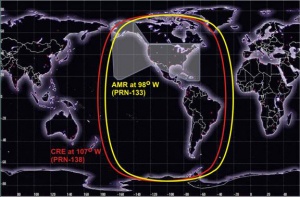If you wish to contribute or participate in the discussions about articles you are invited to contact the Editor
WAAS Space Segment
| WAAS | |
|---|---|
| Title | WAAS Space Segment |
| Author(s) | GMV. |
| Level | Basic |
| Year of Publication | 2011 |
The Wide Area Augmentation System (WAAS) is an GPS Augmentation system developed by the Federal Aviation Administration (FAA), with the goal of improving its accuracy, integrity, and availability. Essentially, WAAS is intended to enable aircraft to rely on GPS for all phases of flight, including precision approaches to any airport within its coverage area.
WAAS uses a network of ground-based reference stations, in North America and Hawaii, to measure small variations in the GPS satellites' signals in the western hemisphere. Measurements from the reference stations are routed to master stations, which queue the received Deviation Correction (DC) and send the correction messages to geostationary WAAS satellites in a timely manner (every 5 seconds or better). Those satellites broadcast the correction messages back to Earth, where WAAS-enabled GPS receivers use the corrections while computing their positions to improve accuracy.[1]
WAAS Space Segment
The WAAS Space Segment consists of multiple geosynchronous communication satellites (GEO) which broadcast the correction messages generated by the Wide-area Master Stations for reception by the User segment. The satellites also broadcast the same type of range information as normal GPS satellites, effectively increasing the number of satellites available for a position fix. As of January 2011, the Space segment consists of two commercial satellites, Inmarsat-4 F3 and Telesat's Anik F1R, with Intelsat's Galaxy 15 planned to resume service before March, 2011.[2]
The original two WAAS satellites, named Pacific Ocean Region (POR) and Atlantic Ocean Region-West (AOR-W), were leased space on Inmarsat III satellites. These satellites ceased WAAS transmissions on July 31, 2007. With the end of the Inmarsat lease approaching, two new satellites (Galaxy 15 and Anik F1R) were launched in late 2005. Galaxy 15 is a PanAmSat, and Anik F1R is a Telesat. As with the previous satellites, these are leased services under the FAA's Geostationary Satellite Communications Control Segment contract with Lockheed Martin for WAAS geostationary satellite leased services, who is contracted to provide up to three satellites through the year 2016. Since September 23, 2008, the ranging data that Galaxy 15 and Anik F1R transmit have been flagged as "Precision Approach". The Galaxy 15 satellite ceased responding to control commands between April 5, 2010, when solar activity damaged the spacecraft’s communication package, and December 23, 2010, when its battery drained and the Baseband Equipment command unit reset.[14] During this time, the satellite drifted from its original location of 133 degrees west to 93 degrees west, but the WAAS signal continued to be broadcast until December 16, 2010. As of January 2011, Intelsat expects to be able to return the satellite to its original location by early March, 2011

